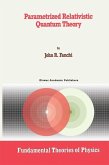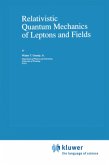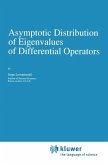- Broschiertes Buch
- Merkliste
- Auf die Merkliste
- Bewerten Bewerten
- Teilen
- Produkt teilen
- Produkterinnerung
- Produkterinnerung
'Et moi ..... si j'avait su comment en revenir, One service mathematics has rendered the je n'y serais point aIle.' human race. It has put common sense back Jules Verne where it belongs. on the topmost shelf next to the dusty canister labelled 'discarded non· The series is divergent; therefore we may be sense'. able to do something with it. Eric T. Bell O. Heaviside Mathematics is a tool for thought. A highly necessary tool in a world where both feedback and non linearities abound. Similarly, all kinds of parts of mathematics serve as tools for other parts and for other sciences. Applying a…mehr
Andere Kunden interessierten sich auch für
![Parametrized Relativistic Quantum Theory Parametrized Relativistic Quantum Theory]() John R. FanchiParametrized Relativistic Quantum Theory153,99 €
John R. FanchiParametrized Relativistic Quantum Theory153,99 €![Quantum Paradoxes and Physical Reality Quantum Paradoxes and Physical Reality]() F. SelleriQuantum Paradoxes and Physical Reality153,99 €
F. SelleriQuantum Paradoxes and Physical Reality153,99 €![Relativistic Quantum Mechanics of Leptons and Fields Relativistic Quantum Mechanics of Leptons and Fields]() W. T. GrandyRelativistic Quantum Mechanics of Leptons and Fields176,99 €
W. T. GrandyRelativistic Quantum Mechanics of Leptons and Fields176,99 €![Renormalized Quantum Field Theory Renormalized Quantum Field Theory]() O. I. ZavialovRenormalized Quantum Field Theory77,99 €
O. I. ZavialovRenormalized Quantum Field Theory77,99 €![Theory of Nucleus Theory of Nucleus]() A. SitenkoTheory of Nucleus224,99 €
A. SitenkoTheory of Nucleus224,99 €![Asymptotic Distribution of Eigenvalues of Differential Operators Asymptotic Distribution of Eigenvalues of Differential Operators]() Serge LevendorskiiAsymptotic Distribution of Eigenvalues of Differential Operators39,99 €
Serge LevendorskiiAsymptotic Distribution of Eigenvalues of Differential Operators39,99 €![Questions About Elastic Waves Questions About Elastic Waves]() Jüri EngelbrechtQuestions About Elastic Waves52,99 €
Jüri EngelbrechtQuestions About Elastic Waves52,99 €-
-
-
'Et moi ..... si j'avait su comment en revenir, One service mathematics has rendered the je n'y serais point aIle.' human race. It has put common sense back Jules Verne where it belongs. on the topmost shelf next to the dusty canister labelled 'discarded non· The series is divergent; therefore we may be sense'. able to do something with it. Eric T. Bell O. Heaviside Mathematics is a tool for thought. A highly necessary tool in a world where both feedback and non linearities abound. Similarly, all kinds of parts of mathematics serve as tools for other parts and for other sciences. Applying a simple rewriting rule to the quote on the right above one finds such statements as: 'One service topology has rendered mathematical physics .. .'; 'One service logic has rendered com puter science .. .'; 'One service category theory has rendered mathematics .. .'. All arguably true. And all statements obtainable this way form part of the raison d'etre of this series.
Produktdetails
- Produktdetails
- Mathematics and its Applications .56
- Verlag: Springer / Springer Netherlands
- Artikelnr. des Verlages: 978-94-010-7392-9
- Softcover reprint of the original 1st ed. 1990
- Seitenzahl: 252
- Erscheinungstermin: 26. September 2011
- Englisch
- Abmessung: 235mm x 155mm x 14mm
- Gewicht: 369g
- ISBN-13: 9789401073929
- ISBN-10: 9401073929
- Artikelnr.: 40769661
- Herstellerkennzeichnung Die Herstellerinformationen sind derzeit nicht verfügbar.
- Mathematics and its Applications .56
- Verlag: Springer / Springer Netherlands
- Artikelnr. des Verlages: 978-94-010-7392-9
- Softcover reprint of the original 1st ed. 1990
- Seitenzahl: 252
- Erscheinungstermin: 26. September 2011
- Englisch
- Abmessung: 235mm x 155mm x 14mm
- Gewicht: 369g
- ISBN-13: 9789401073929
- ISBN-10: 9401073929
- Artikelnr.: 40769661
- Herstellerkennzeichnung Die Herstellerinformationen sind derzeit nicht verfügbar.
1. The Problem of Control on the Quantum Level.- 1.1. Introduction.- 1.2. A Quantum Process as the Object of Control.- 1.3. Problems of Control in Different Descriptions.- 1.4. Obtaining a Prescribed Pure State or a State in its Vicinity.- 1.5. Control with the Aim of Obtaining a Specified Probability of a Given Pure State.- 1.6. Obtaining the Maximum (or Minimum) Probability of a Specified Value of a Physical Quantity.- 1.7. Obtaining a Desired Distribution of Probability Amplitudes for Values of Given Physical Quantities.- 1.8. Control of Quantum Averages and Moments of Physical Quantities.- 1.9. Control of the Distributions of Eigenvalues of Physical Quantities.- 1.10. Control of Operators of Physical Quantities.- 1.11. Measurement in Systems with Feedback.- 2. Controllability and Finite Control of Quantum Processes (Analytical Methods).- 2.1. Control of Pure States of Quantum Processes.- 2.2. Local Controllability in the Vicinity of a Pure State.- 2.3. Global Asymptotic Controllability of Pure States.- 2.4. Control of the Electron in a Rectangular Potential Well.- 2.5. Control of a Two-Spin System.- 2.6. Finite Control of a Particle Spin State.- 2.7. Control of Quantum Averages of Physical Quantities.- 2.8. Control of Coherent States of a One-Dimensional Quantum Oscillator by Means of an External Force.- 2.9. Control of a One-Dimensional Quantum Oscillator by Varying its Eigenfrequency.- 2.10. Obtaining a Specified Probability of a Given State of a Charged Particle by Means of an External Magnetic Field.- 2.11. Control of the State of a Free Particle by an External Force.- 2.12. Control of the Coefficients of Linear Differential Equations Impulse Control.- 2.13. Control of Magnetization.- 3. Controllability and Finite Control (Algebraic Methods).- 3.1. Algebraic Conditions for the Controllability of a Quantum Process.- 3.2. Control on the Motion Groups of Quantum Systems.- 3.3. The Structure of the Algebra of a Quantum System.- 3.4. The Accessible Set of Evolution Matrices.- 3.5. Designing Discrete Automata on Controlled Transitions of Quantum Systems.- 4. Optimal Control of Quantum-Mechanical Processes.- 4.1. General Formulation of the Control Problem for a Quantum Statistical Ensemble.- 4.2. Variational Control Problems.- 4.3. Necessary Conditions for an Extremum.- 4.4. Methods of Solving Boundary Value Optimization Problems.- 4.5. Methods of Direct Optimization on Unitary Groups.- 4.6. Maximization of the Probability of Observing a Given State of a Quantum System.- 5. Dynamical Systems with Stored Energy and Negative Susceptibility.- 5.1. The Effect of Negative Susceptibility of Dynamical Systems and its Applications.- 5.2. Synthesis of Bipolar Circuits with Negative Impedance and Negative Conductivity.- 5.3. Negative Susceptibility in Gyroscopically Related Systems.- 5.4. Transverse Susceptibility of a Rigid Dipole in an Inversely Directed Constant Field.- 5.5. Negative Susceptibility of a Parametrically Modulated Oscillator.- 5.6. Systems with Stored Energy.- 5.7. Static Susceptibility of Adiabatically Invariant Control Systems.- 5.8. Conditions for Negative Static Susceptibility in Quantum Systems.- 6. Negative Susceptibility in Parametrically Induced Magnetics.- 6.1. Induced Superdiamagnetism and its Application to Distributed Control.- 6.2. Superdiamagnetic States in Inversely Magnetized Ferromagnetic Media.- 6.3. Superdiamagnetism and Parametrically Stimulated Anomalous Gyrotropy.- 6.4. Low-Frequency Susceptibility of a Gyromagnetic Medium.- 6.5. Stability of Spin Waves in Longitudinal Pumping of Ferromagnetic Crystals.-6.6. Applications.- Appendix 1. Mathematical Models of Quantum Processes.- Appendix 2. Controllability and Finite Control of Dynamical Systems.- A2.1. Controllability and Finite Control of Linear Finite-Dimensional Systems.- A2.2. Finite Control of Linear Distributed Systems.- A2.3. A New Differential Geometric Method of Solving the Problems of Finite Control of Non-Linear Finite-Dimensional Dynamical Systems.- Appendix 3. Continuous Media and Controlled Dynamical Systems (CDS's). The Maximum Principle for Substance Flow. The Laplacian of a CDS.- References.
1. The Problem of Control on the Quantum Level.- 1.1. Introduction.- 1.2. A Quantum Process as the Object of Control.- 1.3. Problems of Control in Different Descriptions.- 1.4. Obtaining a Prescribed Pure State or a State in its Vicinity.- 1.5. Control with the Aim of Obtaining a Specified Probability of a Given Pure State.- 1.6. Obtaining the Maximum (or Minimum) Probability of a Specified Value of a Physical Quantity.- 1.7. Obtaining a Desired Distribution of Probability Amplitudes for Values of Given Physical Quantities.- 1.8. Control of Quantum Averages and Moments of Physical Quantities.- 1.9. Control of the Distributions of Eigenvalues of Physical Quantities.- 1.10. Control of Operators of Physical Quantities.- 1.11. Measurement in Systems with Feedback.- 2. Controllability and Finite Control of Quantum Processes (Analytical Methods).- 2.1. Control of Pure States of Quantum Processes.- 2.2. Local Controllability in the Vicinity of a Pure State.- 2.3. Global Asymptotic Controllability of Pure States.- 2.4. Control of the Electron in a Rectangular Potential Well.- 2.5. Control of a Two-Spin System.- 2.6. Finite Control of a Particle Spin State.- 2.7. Control of Quantum Averages of Physical Quantities.- 2.8. Control of Coherent States of a One-Dimensional Quantum Oscillator by Means of an External Force.- 2.9. Control of a One-Dimensional Quantum Oscillator by Varying its Eigenfrequency.- 2.10. Obtaining a Specified Probability of a Given State of a Charged Particle by Means of an External Magnetic Field.- 2.11. Control of the State of a Free Particle by an External Force.- 2.12. Control of the Coefficients of Linear Differential Equations Impulse Control.- 2.13. Control of Magnetization.- 3. Controllability and Finite Control (Algebraic Methods).- 3.1. Algebraic Conditions for the Controllability of a Quantum Process.- 3.2. Control on the Motion Groups of Quantum Systems.- 3.3. The Structure of the Algebra of a Quantum System.- 3.4. The Accessible Set of Evolution Matrices.- 3.5. Designing Discrete Automata on Controlled Transitions of Quantum Systems.- 4. Optimal Control of Quantum-Mechanical Processes.- 4.1. General Formulation of the Control Problem for a Quantum Statistical Ensemble.- 4.2. Variational Control Problems.- 4.3. Necessary Conditions for an Extremum.- 4.4. Methods of Solving Boundary Value Optimization Problems.- 4.5. Methods of Direct Optimization on Unitary Groups.- 4.6. Maximization of the Probability of Observing a Given State of a Quantum System.- 5. Dynamical Systems with Stored Energy and Negative Susceptibility.- 5.1. The Effect of Negative Susceptibility of Dynamical Systems and its Applications.- 5.2. Synthesis of Bipolar Circuits with Negative Impedance and Negative Conductivity.- 5.3. Negative Susceptibility in Gyroscopically Related Systems.- 5.4. Transverse Susceptibility of a Rigid Dipole in an Inversely Directed Constant Field.- 5.5. Negative Susceptibility of a Parametrically Modulated Oscillator.- 5.6. Systems with Stored Energy.- 5.7. Static Susceptibility of Adiabatically Invariant Control Systems.- 5.8. Conditions for Negative Static Susceptibility in Quantum Systems.- 6. Negative Susceptibility in Parametrically Induced Magnetics.- 6.1. Induced Superdiamagnetism and its Application to Distributed Control.- 6.2. Superdiamagnetic States in Inversely Magnetized Ferromagnetic Media.- 6.3. Superdiamagnetism and Parametrically Stimulated Anomalous Gyrotropy.- 6.4. Low-Frequency Susceptibility of a Gyromagnetic Medium.- 6.5. Stability of Spin Waves in Longitudinal Pumping of Ferromagnetic Crystals.-6.6. Applications.- Appendix 1. Mathematical Models of Quantum Processes.- Appendix 2. Controllability and Finite Control of Dynamical Systems.- A2.1. Controllability and Finite Control of Linear Finite-Dimensional Systems.- A2.2. Finite Control of Linear Distributed Systems.- A2.3. A New Differential Geometric Method of Solving the Problems of Finite Control of Non-Linear Finite-Dimensional Dynamical Systems.- Appendix 3. Continuous Media and Controlled Dynamical Systems (CDS's). The Maximum Principle for Substance Flow. The Laplacian of a CDS.- References.









